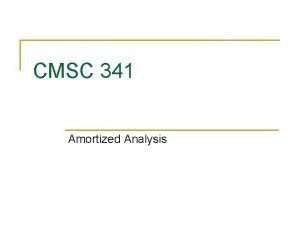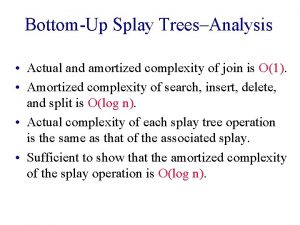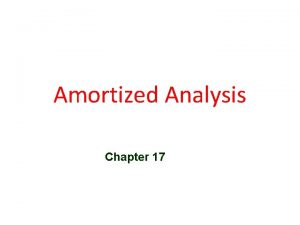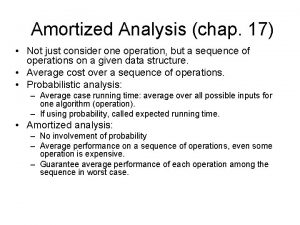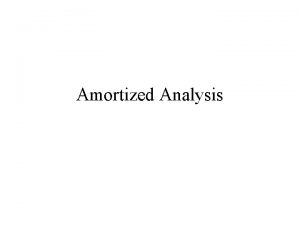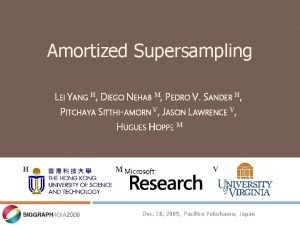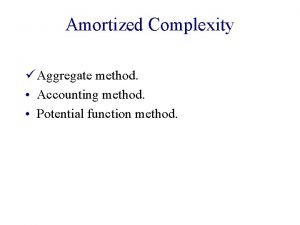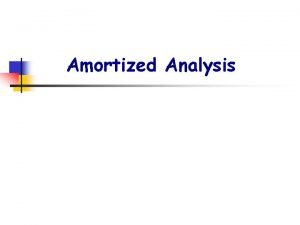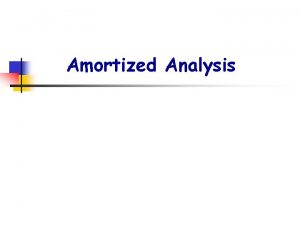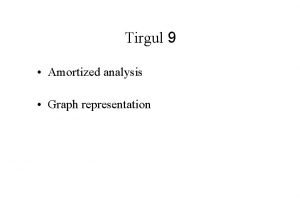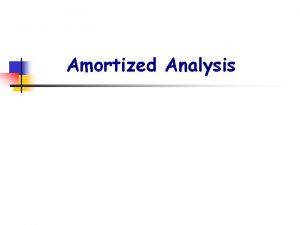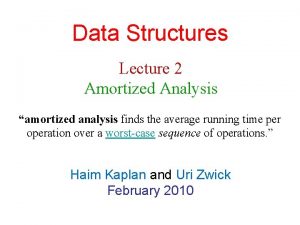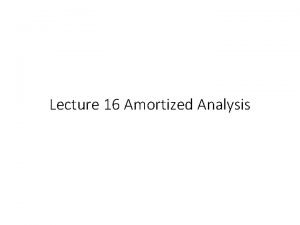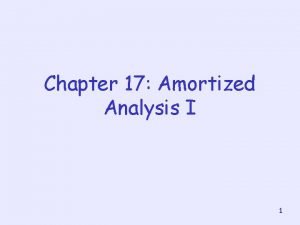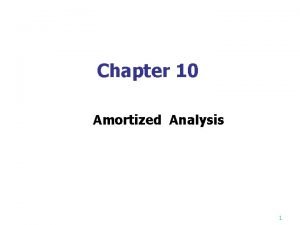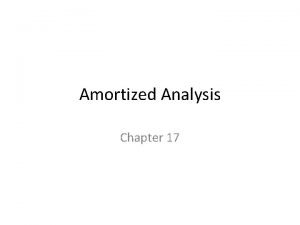CHAPTER 17 Amortized Analysis In an amortized analysis


![Aggregate Method (a binary counter) • We use an array A[0, 1, …, k-1] Aggregate Method (a binary counter) • We use an array A[0, 1, …, k-1]](https://slidetodoc.com/presentation_image_h2/800966ef153eb29e85370d5816ab68aa/image-3.jpg)












- Slides: 15

CHAPTER 17 Amortized Analysis • In an amortized analysis, the time required to perform a sequence of data structure operations is averaged over all the operations performed. • It can be used to show that the average cost of an operation is small, if one averages over a sequence of operations. • While a particular operation in sequence may be expensive, this operation may not occur often enough to make the average cost expensive. • An amortized analysis guarantees the average performance of each operation in the worst case. • It determines the average time without the use of probability. • Three methods are covered in text. The main difference is the way the cost is assigned. • Aggregate Method Characteristics – Computes the worst case time T(n) for a sequence of n operations. – The amortized cost (the average cost) per operation is T(n)/n – Gives average performance of each operation in the worst case. – This method is less precise than other methods, as all operations are assigned the same cost. Advanced Algorithms, Feodor F. Dragan, Kent State University 1

Aggregate Method • An Aggregate Method Example: (Stack Operations) • Assume the following three operations on a stack: • push(S, x) - pushes x onto stack S • pop(S) - pops & returns top of stack S • multipop(S, k) - pops and returns the top min{k, |S|} items of S. • Worst case cost for Multipop is O(n) – n successive calls to Multipop would cost O(n 2). • Consider a sequence of n push, pop and multipop operations on an initially empty stack. • This O(n 2) cost is unfair. • Each item can be popped only once for each time it is pushed. • In a sequence of n mixed operations, the most times multipop can be called is n/2. • Since the cost of push and pop is O(1), the cost of n stack operations is O(n). • Therefore, the average cost of each stack operation in this sequence is O(n)/n or O(1). Advanced Algorithms, Feodor F. Dragan, Kent State University 2
![Aggregate Method a binary counter We use an array A0 1 k1 Aggregate Method (a binary counter) • We use an array A[0, 1, …, k-1]](https://slidetodoc.com/presentation_image_h2/800966ef153eb29e85370d5816ab68aa/image-3.jpg)
Aggregate Method (a binary counter) • We use an array A[0, 1, …, k-1] of bits, where length(A)=k, as a counter. • A binary number x that is stored in the counter has its lowest order bit in A[0] and highest-order bit in A[k-1], so that Initially x=0 (A[I]=0 for all i). • To add 1 (modulo ) to the value of the counter we use the following procedure. INCREMENT(A) { i=0 while i<length[A] and A[i]=1 do { A[i]=0; i=i+1 } if i<length[A] then A[i]=1 } • A single execution of INCREMENT takes O(k) in the worst case (if A contains all 1’s). • A sequence of n INCREMENT operations on an initially zero counter takes time O(kn) in the worst case. (? ? ? Is this true? ) • We can tighten our analysis to yield a worst case cost of O(n) operations for a sequence of n INCREMENT’s by observing that not all bits flip each time INCREMENT is called. • For i=0, 1, …[log n], bit A[i] flips times in a sequence of n INCREMENT operations on an initially zero counter. For i>[log n] bit A[i] never flips at all. • The total number of flips in the sequence is thus • Therefore, the worst-case time for a sequence of n INCREMENT operations on an initial zero counter is O(n). The average cost of each operation, and therefore the amortized cost per operation , is O(n)/n=O(1). Advanced Algorithms, Feodor F. Dragan, Kent State University 3

Accounting Method • The Accounting Method Characteristics – Assign different (artificial) charges to different operations. The amount we charge an operation is called its amortized cost. – When an operation’s amortized cost exceeds its actual cost, the difference is assigned to specific objects in the data structure as credit. – Credit can be used later on to help pay for operations whose amortized cost is less than their actual cost. – The balance in the bank account is not allowed to become negative. – The sum of the amortized costs for any sequence of operations must be an upper bound for the actual total cost of these operations. – The amortized cost of each operation must be chosen wisely in order to pay for each operation on or before the cost is incurred. • An Accounting Method Example: (stack operations) – Recall the actual costs of these operations were • push (S, x) 1 • pop (S) 1 • multipop(S, k) min(k, |S|) (complexity depends on k) – The amortized costs assigned are • push 2 • pop 0 • multipop 0 – Observe that the amortized cost of each operation is O(1). Advanced Algorithms, Feodor F. Dragan, Kent State University 4

Accounting Method (examples) • We must now show that we can pay for any sequence of stack operations by charging the amortized cost (recall that we start with initially empty stack). • The two unit costs associated with each push is used as follows: • 1 unit is used to pay the cost of the push. • 1 unit is collected in advance to pay for a potential future pop. • For any sequence of n operations of push, pop, and multipop, the total amortized cost is an upper bound on the total actual cost. • Since the total amortized cost is O(n), so is the total actual cost. • In incrementing a binary counter, we observed earlier, the running time of this operation is proportional to the number of bits flipped, which we will use as our cost for this example. • For the amortized analysis, let as charge an amortized cost of 2 dollars to set a bit to 1. • When a bit is set, we use 1 dollar to pay for the actual setting of the bit, and we place the other dollar on the bit as credit to be used later when we flip the bit back to 0. • The amortized cost of an INCREMENT operation is at most 2 dollars INCREMENT(A) { i=0 while i<length[A] and A[i]=1 do { A[i]=0; i=i+1 } if i<length[A] then A[i]=1 } • Thus, for n INCREMENT operations, the total amortized cost is O(n), which bounds the total actual cost. Advanced Algorithms, Feodor F. Dragan, Kent State University 5

The Potential Method • This method stores prepayments as a potential to pay for future operations. – The potential stored is associated with the entire data structure rather than with a specific item in that data structure. – Notation: • Do is the initial data structure (e. g. , stack) • Di is the data structure after the ith operation • ci is the actual cost of the ith operation. • The potential function (i. e. , psi) maps each Di to its potential value, (Di). – The amortized cost i of the ith operation is defined by i = ci + (Di) - (Di-1). • Note: i = (actual cost) + (change in potential) – The total amortized cost is – By requiring that for all i, we insure that the total amortized cost is an upper bound for the actual cost for any sequence ( choose appropriate ). Advanced Algorithms, Feodor F. Dragan, Kent State University 6

The Potential Method (cont. ) • If then i is an overcharge for the ith operation and causes an increase in potential. • Similarly, if then i is an undercharge and results in a decrease in potential. • A Potential Method Example: (Stack Operations) – The data structure D is initially an empty stack. – Let (D) be the number of items in the stack. Then (D 0) = 0 and (Di) 0 i – push operation : If the ith operation on D is a push, then (Di) - (Di-1) = (Di-1) +1 - (Di-1) = 1 – The amortized cost for a push is i = ci + [ (Di) - (Di-1)] = 1 +1 = 2 – multipop operation: If the ith operation is multipop(D, k) and k = min{|D|, k}, then ci = k and i = ci + [ (Di) - (Di-1)] = k - k = 0 – pop operation: Hence, if pop is the ith operation, then i= 0 – COST ANALYSIS: • The amortized cost for each operation is O(1). • The amortized cost of n operations is O(n). • The upper bound for the total cost is O(n). Advanced Algorithms, Feodor F. Dragan, Kent State University 7

Dynamic Table Problem • Problem: Consider the cost of a sequence of TABLE-DELETE and TABLEINSERT commands for a dynamic table – Normally, cost of a insertion or deletion is 1. – However cost is large if a table expansion or contraction is triggered by the add or delete. –Analysis given here is independent of the data structure used. • Restricted Dynamic Table Problem (Insertions) – Only insertions are allowed. – Goal: Try to keep the table as small as possible. – Must enlarge table when too many items inserted – Proposed Idea for Algorithm: 1. Initialize table size to m = 1 2. Insert elements until the number n of elements satisfies n > m. 3. Generate a new table of size 2 m and set m 2 m 4. Re-insert old elements into the new table. 5. Go to step 2. · Let ci be the cost of the ith insert. Then Advanced Algorithms, Feodor F. Dragan, Kent State University 8

Aggregate Analysis • Worst case is O(n). • If repeated n times, is a worst case of O(n 2) possible? • Illustration: Insertion Size Cost 1 1 1 2 2 1+1 3 4 1+2 4 4 1 5 8 1+4 6 8 1 7 8 1 8 8 1 9 16 1+8 10 16 1 • Aggregate Analysis: – n inserts cost – Average cost of each operation = (Total Cost) / (Nr. of Operations) = 3 – Asymptotically, cost is O(1) or the same as for a table of fixed size. Advanced Algorithms, Feodor F. Dragan, Kent State University 9

Accounting Analysis – Avoids math if you can guess charges that work. – Charge each operation 3 units for amortized cost: • use 1 to perform immediate insertion • store 2 – When table doubles, • use 1 unit to re-insert items added since last copy. • use 1 unit to re-insert items copied previously. Potential Analysis – Define (T) = 2 num(T) - size(T) – Immediately after an expansion but before a new item is inserted num(T) = size(T) / 2 which implies that (T) = 0 – Also, when the table is empty, (T) = 0. – Since the table is always half-full (T) 0 – Some useful definitions: numi = number of elements after ith operation sizei = table size after ith operation i = potential after ith operation – Since num 0 = size 0, it follows that 0 = 0 – If ith insertion does not trigger an expansion, then sizei = sizei-1 and i = ci + i-1 = 1 + (2 numi - sizei ) - (2 numi-1 - sizei-1) = 1 + (2 numi - sizei ) - 2 (numi - 1) + sizei = 3 Advanced Algorithms, Feodor F. Dragan, Kent State University 10

Potential Analysis (cont. ) – If the ith insertion causes an expansion, then and i = ci + i - i-1 = numi + (2 numi - sizei ) - (2 numi-1 - sizei-1) = numi + 2 numi - 2 (numi - 1) - [2 (numi - 1) - (numi - 1)] = 3 . . . Definition: The load factor of a nonempty table T is Observations: 1. and 2. If T is empty, then num(T ) = 0. – It is natural and useful to define for empty table – size(T ) = 0 – =1 – Note that these definitions preserve the equality in the first preceding observation. Advanced Algorithms, Feodor F. Dragan, Kent State University 11

Dynamic Tables with Insert and Delete • Goal: - Keep the load factor of the dynamic table bound below by a positive constant. - Keep the amortized cost of each table operation bounded above by a constant. • Proposed Plan: When the table usage drops below ½ , we could reduce the table to one-half its size. • Problem: This may cause thrashing. If a table is initially full, consider the following operations: I DD II … • A sequence of n insertions to fill the table, followed by a sequence of the above n operations has an average cost of O(n) per operation. • We avoid this problem by waiting until the table is well below ½ full before contracting it. • By contracting the table when it falls below ¼ full, we maintain the lower bound • If the table becomes empty, we cut its size to 0. Advanced Algorithms, Feodor F. Dragan, Kent State University 12

Analysis by the Potential Method – Goal: We want the potential (T ) to satisfy (T ) = 0 immediately following a contraction/expansion (before any element is added/deleted). – (T ) builds to pay for a change as the load factor approaches ¼ or 1. Definition: – Properties: – Both branches of formula agree (and equal 0) at their switchover point, – If , then So the potential can pay to move each item. – If , then and So the potential can pay to move each item. – (T) is zero immediately after each table expansion or contraction. – Exercise: Consider graph of (T) over [8, 32] immediately after num increases from 16 to 17. Advanced Algorithms, Feodor F. Dragan, Kent State University 13

Analysis by the Potential Method (INSERT) – Notation: The subscript i in will denote their values after the ith operation. – Observation: Recall that initially – Case 1: Suppose the ith operation is INSERT and Then the analysis is same as for a table allowing only INSERT and = 3. – Case 2: Suppose the ith operation is INSERT and = ci + i - i-1 = 1+ (½ sizei - numi ) - (½ sizei-1 - numi-1) = 1 + ½ sizei - numi - ½ sizei + numi - 1= 0. – Case 3: Suppose the ith operation is INSERT and = ci + i - i-1 = 1+ (2 numi - sizei) - (½ sizei-1 - numi-1) = 1 + (2 (numi-1+1) - sizei-1) – (½ sizei-1 - numi-1) = 3 numi-1 – ½ (3 sizei-1)+3= 3 sizei-1 – ½ (3 sizei-1)+3 < 3/2 sizei-1 - 3/2 sizei-1)+3 = 3. • Thus, for an INSERT, the amortized cost is Advanced Algorithms, Feodor F. Dragan, Kent State University 14

Analysis by the Potential Method (DELETE) – Case 4: Suppose the ith operation is DELETE and but a deletion does not cause a contraction. An easy calculation (in text) shows that – Case 5: Suppose but deletion causes a contraction. – one item is deleted, leaving numi items to move, so ci = 1+ numi. – note that sizei = ½ sizei-1 = 2 numi-1 = 2(numi + 1). – Then, = ci + i - i-1 = 1+ numi + (½ sizei - numi ) - (½ sizei-1 - numi-1) = 1+ numi + 1 - numi – 2 numi - 2 + numi + 1 = 1. – Case 6: and ith operation is a deletion. – By Exercise 17. 4 -2, the amortized cost function is bounded above by a constant. with respect to the potential – Exercise 17. 4 -2 is assigned as homework. – In all cases, the amortized cost for each operation is bounded above by a constant. – Thus, the actual time for n insert and delete operations on a dynamic table is O(n). Advanced Algorithms, Feodor F. Dragan, Kent State University READ Ch. 17 in CLRS. 15
 Amortized analysis
Amortized analysis Dynamic arrays and amortized analysis
Dynamic arrays and amortized analysis Splay tree amortized analysis
Splay tree amortized analysis Stack analysis
Stack analysis Define amortized analysis
Define amortized analysis Amortized analysis
Amortized analysis Amortized computational complexity
Amortized computational complexity Amortized complexity
Amortized complexity Amortized supersampling
Amortized supersampling Accounting method
Accounting method Structured analysis tools
Structured analysis tools Cuckoo
Cuckoo Content analysis and discourse analysis
Content analysis and discourse analysis Differences between contrastive analysis and error analysis
Differences between contrastive analysis and error analysis Types of intralingual errors
Types of intralingual errors Observation in system analysis and design
Observation in system analysis and design
